140 Search Results for tabi
May 21, 2012
by Carole Zangari -
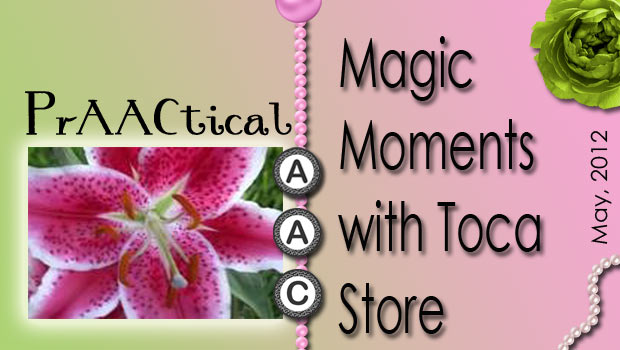
It’s no coincidence that some of our favorite apps to use with AAC kids don’t rely on good receptive language in order to be successful and have fun. Count us among the fans of Toca Boca for their creative play-based apps with great graphics and lots of repetition with variety. In this post, we share some Magic Moments for using Toca Store as a communication-building experience.– 1. Core Word Practice: Lots of opportunities for practice with familiar nouns (e.g., banana, doll), common verbs (e.g., get, see, want) and modifiers (colors, some, little). 2. Negation: This is another fun app to use when teaching a child to use language appropriate for negation, protests, and rejection. We like teaching that under low stress conditions like this at first to build their skills. Once they get the hang of it, then we help them use it under more natural conditions. That way we can... [Read More...]
May 19, 2012
by Carole Zangari -
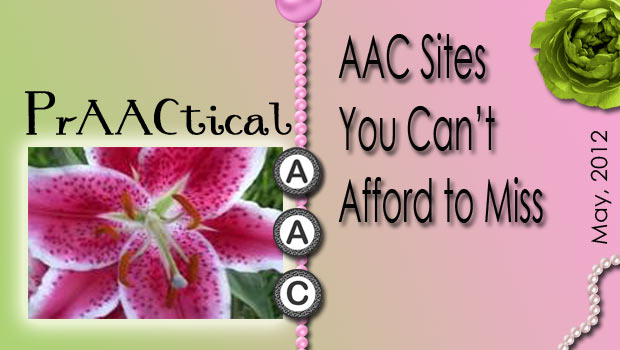
We continue to celebrate ASHA’s Better Hearing and Speech Month with a focus on SLPs, specifically, strengthening our AAC connections in this digital world. This week we focus on websites that we find useful in our AAC work with graduate students, colleagues, clients, and families. – Ten years ago if you would have told us that sharing a list of useful AAC websites would seem dated and ‘old school,’ we would have either burst out laughing or withdrawn into a catatonic state. Now, however, it does seem a little old-fashioned to share a list of websites. Here is our starter list of sites to visit, explore, and bookmark. – 1. Resource and Training Material: The breadth, depth, and quality of the offerings by SET BC makes it one of our most frequented online resources. Downloadable AAC materials? Check! Curriculum supports? Got it! Accessible books? Yup! Training resources? Just wait ‘til... [Read More...]
May 2, 2012
by Carole Zangari -
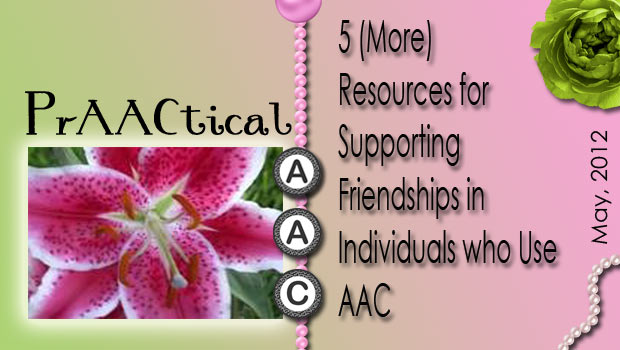
– 1. We love this article by ConnectAbility on helping children build friends. – 2. Online connections can be fun, too. AAC Small Talk is a Yahoo group for kids who use AAC and their friends. It’s hosted by Pam Harris and Dr. Jill Senner. – 3. Games and friends go hand-in-hand, but sometimes a little adult support is needed. We really liked the ideas in this post by SLP Tahirih Bushey on how to choose and play games that build communication: http://bit.ly/J3IMtM 4. Novita Children’s Services has some wonderful information about helping friendships to develop: http://bit.ly/HQQoMD – 5. Explaining AAC to a child’s friends and classmates doesn’t have to be hard! We love this PowerPoint by master AAC clinician Gail Van Tatenhove. She wrote it for students in inclusive classrooms to introduce Minspeak so that they can be good communication partners for their friends who use AAC. – . Want to see our... [Read More...]
April 30, 2012
by Robin Parker -
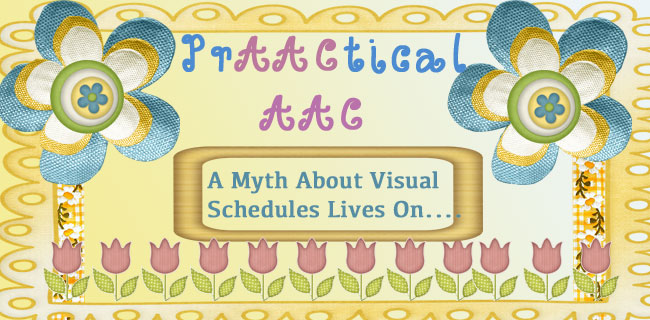
Nooooo, not again. A myth about visual schedules continues to rear its ugly head in a prAACtical situation (maybe we can reframe it into a learning opportunity??). Some history- A parent of twin girls with autism (age 15 and two other younger children– yes total 4) stopped by our office to pick up some autism awareness materials yesterday (a super busy mom in so many ways —going out of her way to help our community). As we were exchanging pleasantries and getting updates on how the girls were doing, we heard something that continues to surprise us–(and not in a good way). What did we hear? We heard that the girls were doing relatively well (not the surprising comment) but that mom was extra busy because the girls were no longer independent in taking their showers. They could do it by themselves but didn’t like the sensory input of soap... [Read More...]
April 29, 2012
by Carole Zangari -
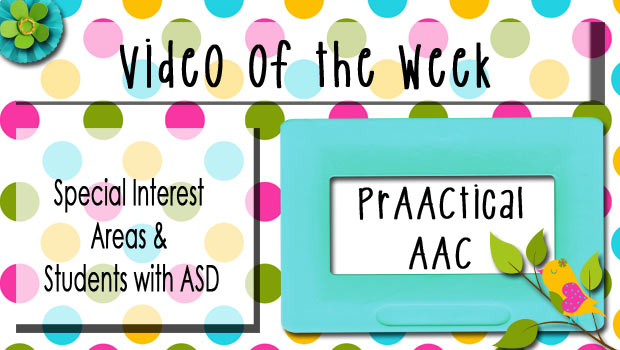
Yesterday, we posted about using special interests to create prAACtical communication opportunities, our AAC intervention strategy of the month. Today, we share this Video of Week on the same topic. The team at ConnectAbility presented this video workshop on Special Interest Areas and Students with Autism Spectrum Disorder. –
April 11, 2012
by Carole Zangari -
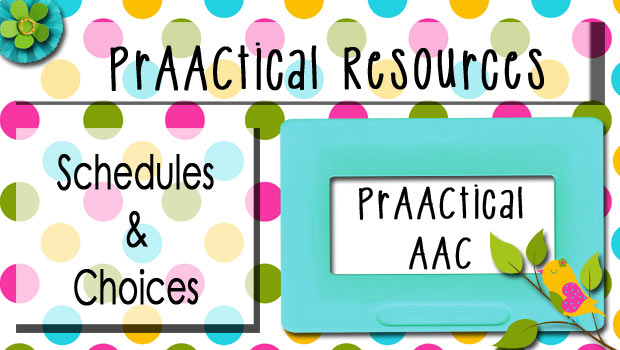
– If you follow our blog, you know that last month we had lots to say on making, teaching, and using Visual Schedules. We ran out of time before we could discuss a question that comes up a lot in our own clinical practice. What role does choice-making play in visual schedules? Here are some of the things we think about when we consider this for the schedules we make and use. We all like to have some say in what we do. Giving the learner an opportunity to make choices in a schedule makes sense when personal autonomy is a priority. Allowing the learner to choose which activities to place on the schedule supports personal autonomy: Having control over what happens in our lives is a big part of happiness for most people. – Here’s how we might do that with a visual schedule for a therapy session. 1.Select... [Read More...]
April 1, 2012
by Robin Parker -
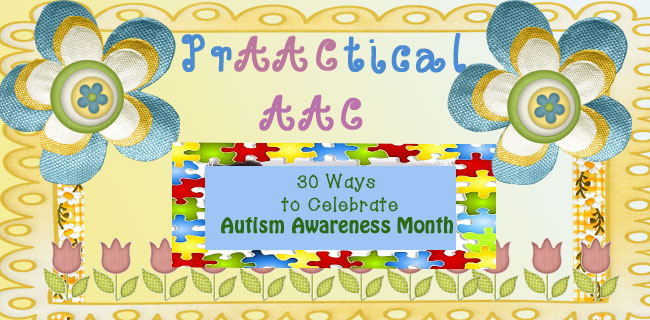
Please check out the most recent set of suggestions here. We love getting EVERYONE involved in Autism Awareness Month. We like to take a goal focused approach to our Autism Awareness Month activities by choosing projects that facilitate positive attitudes & discussions. We pass out materials, have contests, go to events, do extra talks, and try and engage EVERYONE we know and even some we do not know. We do a lot of shopping (with small amount of money, but we have to EAT and accessorize). Our families, pets, friends, and students all participate. It is a month filled with purposeful fun. Here are some of the things we will be doing. Please share any activities or projects that you know about. Bake, share, & eat some desserts. Need inspiration?.. try these Puzzle Piece Rice Crispy Treats Join the webinar Autism Explosion by Dr. Coplan will be shown... [Read More...]
February 17, 2012
by Carole Zangari -
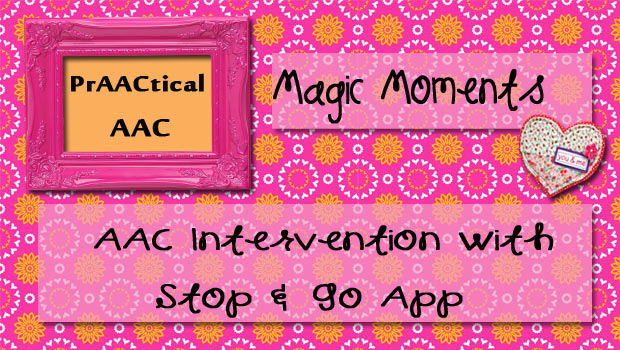
We’re always looking for engaging ways to give our preschool children practice with their core word vocabulary. Stop and Go by ShortStack is an app that will get your little friends using core language without even realizing how much practice they are getting. — We love the simple structure of the app, which shows vehicles stopped at a traffic light. We see and hear the name of the vehicle and then press the green light for the vehicle to go. It has an English or a Spanish option and lots of interactive elements to try and then talk about. — Magic Moments with Stop and Go 1. Core Word Practice: As expected, there are tons of opportunities for the child to move the vehicles in this app. Using the strategy of controlled access, we can elicit ‘stop’ and ‘go’ multiple times in this game. 2. More Core Word Practice –... [Read More...]
January 8, 2012
by Carole Zangari -

A colleague and I taught a workshop awhile back where there was an interesting sidebar conversation. A special educator was trying to convince an administrator that even though her student used a high tech speech generating device (SGD), she still needed the software to create other communication tools, like language boards and visual schedules. Having spent a great deal of money on AAC technology, the administrator was reluctant to commit additional funds for that authoring software. “She has a $5,000 device,” Sally Supervisor said. “Now you’re telling me you need special software to make things you can print out on paper?”The teacher’s point, of course, was a valid one. Children with AAC needs, like the rest of us, communicate in a variety of ways. In most cases, they need access to a variety of tools and the training to use them effectively. Just like we do.We gesture. We write with... [Read More...]
January 8, 2012
by Robin Parker -
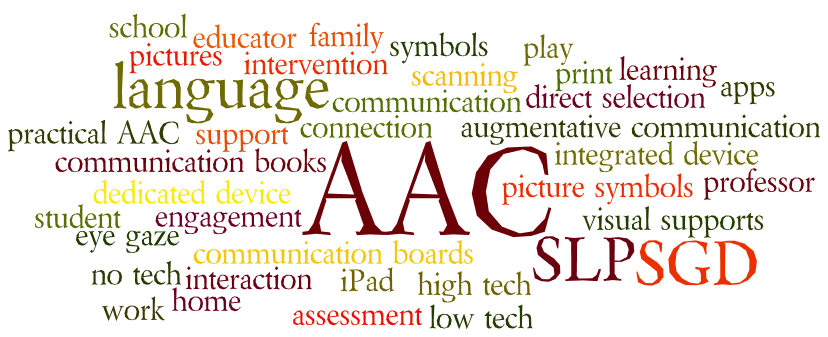
Resolution #2: Get the word out that USING visual supports can help improve behavior: 5 Visual Supports to Make it Easy (it’s more about what WE do – then compliance of the student) 1. Choice Boards 2. First- Then Board 3. Stop/Go Signs 4. Border Tape 5. Break Card









